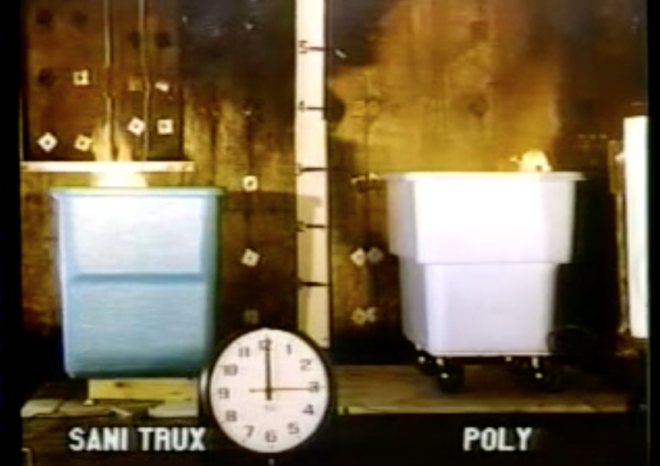
Fire Prevention
Which Cart Do You Think is Really Fire Retardant ?
This is a video of an actual fire test using a Sanitrux fire retardant cart and a Factory Mutual Approved polyethylene cart.
- The Factory Mutual poly cart caught fire within 1 minute with flames shooting to heights of 6 feet.
- Burning, melted polyethylene flowed on the floor within 3 minutes.
- The Fire was extinguished at 4 minutes for safety concerns.
- The Sanitrux cart did not burn or melt, and it’s paper contents remained untouched by fire.
Fire Safety Professional
“Both the NFPA and the International Fire Code have provisions which require material susceptible to spontaneous ignition to be in listed containers, which are designed to contain or suppress a fire, and not contribute additional fuels.
Polyethylene laundry carts do NOT meet these requirements. One third of all laundry managers have suffered a fire. It makes little sense that non-sprinkled laundries continue to operate without listed containers!”
Contributing NFPA code writer: Jim Everitt
Most Information You’ve Heard or Read About Fire Retardant Containers Is Not Accurate. This Is Why Mcclure Industries Is Putting the Record Straight.
It concerns us when businesses purchase carts that claim to be fire retardant, but actually are not. Polyethylene carts are not fire retardant Period.
In order to be listed and certified fire retardant, a cart manufacturer MUST Submit the material to an independent Laboratory that tests it according to ASTM-E 1354, cone calorimeter test, for combustion rate (heat release) and smoke release. The cone calorimeter test is the most reliable test for fire retardant standards, unlike the Factory Mutual Test, FM 6921, which provides no assurance of the fire code compliance for the tested container.
The structural fiberglass in Sanitrux carts has been tested to these rigid standards by Warnock Hersey/Intertek. Sanitrux are “listed” carts and have been given class II Fire Retardant classification.
What Does That Mean To You ?
It means that you KNOW when you buy Sanitrux, it is Class II Fire Retardant. And you KNOW without question that it meets the mandates of all public safety and fire codes. You know that you have absolutely taken the appropriate steps to safeguard your business and your employees. We’ve loaded the site with reports for you by fire professionals. We want you to be the most informed buyer possible so you purchase exactly what is needed for your business, you know exactly what you are purchasing and you can feel assured you’ve made the best purchase.
NFPA reports the following losses to non-residential properties by fire:
- 2007 Total Reported Fire Loss : $3.1 billion
- International : $872 million
- Cooking Equipment : $126 million
- Electrical : $399 million
- Heating : $212 million
- Smoking Materials : $153 million
- Dryers : $17 million
- Spontaneous Ignition : $67 million
- Rubbish : $1 million